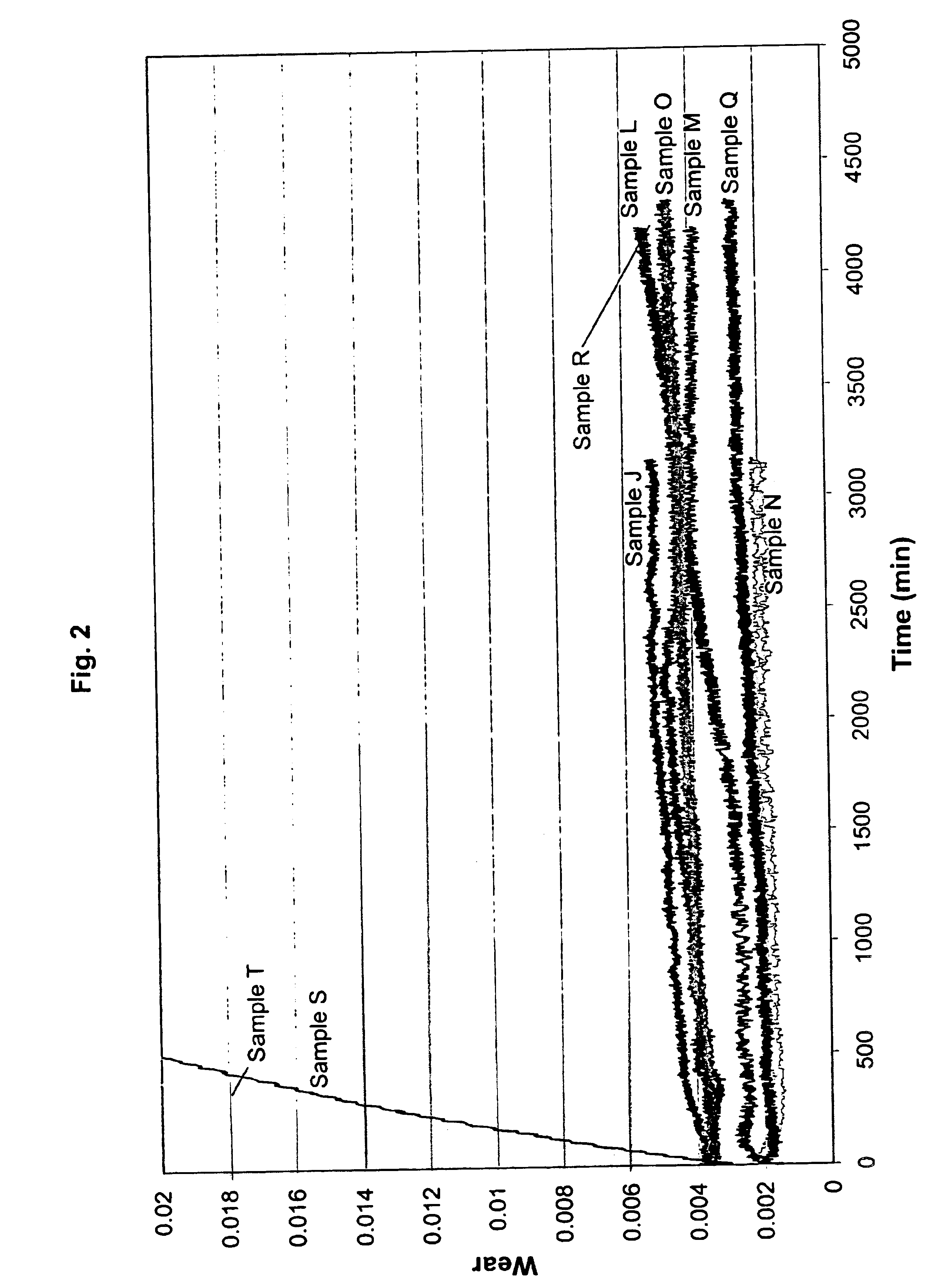Compositions containing polyphenylene ether and/or polystyrene having improved tribological properties and methods for improving tribological properties of polyphenylene ether and/or polystyrene compositions
a technology of polyphenylene ether and polystyrene, which is applied in the direction of tyre parts, vehicle components, electrical equipment, etc., can solve the problems of adversely affecting the impact properties of some polymer composites, increasing the cost and inefficiency of the wear system, and affecting the tribological properties of traditional external lubricants, etc., to improve the tribological properties of a base polymer, improve the tribological properties of a base poly
- Summary
- Abstract
- Description
- Claims
- Application Information
AI Technical Summary
Benefits of technology
Problems solved by technology
Method used
Image
Examples
examples a-h
[0039]Eight compositions were prepared by blending a base polymer containing a blend of 1:1 polyphenylene ether / styrene, a polyolefin, and a compatibilizer. The base polymer was Noryl®731 or Noryl®EN185 (commercially available from General Electric), in which the “EN 185” blend contains a flame retardant. As a compatibilizer, polystyrene-ethylene-butadiene-styrene (SEBS) grade Kraton™ G2705 or G1651 (commercially available from Kraton Polymer) was included. Finally, the polyolefin was either a linear low density polyethylene (LLDPE) (Petrothene GA818-07, commercially available from Equistar) or a polyethylene / polypropylene (PE / PP) copolymer (C105-02, commercially available from Dow Chemical). Each composition contained 7.5% or 15% by weight of total polyolefin and compatibilizer and a 2:1 ratio of polyolefin to compatibilizer. The relative amounts of the components of each composition, denoted A-H, are shown in Table 1.
[0040]The compositions were prepared by hand blending and were e...
example i
[0043]The composition was prepared by the method described above using 100% polystyrene as the base polymer, 15% SEBS (Kraton G1651) as the compatibilizer, and 10% LLDPE as the polyolefin. The wear data for the resulting composition are shown in Table 1 and FIG. 1. The wear factor for composition I was 59×10−11 mm5 / Pa-m, compared with 3900×10−11 mm5 / Pa-m for pure polystyrene. This demonstrates that tribological properties of pure polystyrene can be improved by incorporating an appropriate polyolefin and compatibilizer.
[0044]
TABLE 1Sample No.ABaCDbEFaGHbIComp. 1PPE / PS ratio1:11:11:11:11:11:11:11:1100%PSSEBS typeG1651G1651G2705G1651G2705G2705G1651G2705SEBS wt %552.52.5552.52.515Olefin typeLLDPEPE / PPLLDPELLDPEPE / PPLLDPEPE / PPPE / PPLLDPEPPcopolymercopolymercopolymercopolymerOlefin wt %10105510105510100Tribological PropertiesOverall Wear Factor569555421094415713059234(10−11 mm5 / Pa-m)Dynamic COF0.3490.4430.3090.4090.3650.3380.3290.4220.3280.599Physical PropertiesWater absorption, %0.0620.05...
examples j -
EXAMPLES J-Q
[0045]Fight additional compositions were prepared by the method described above using a 1:1 polyphenylene ether / styrene blend as the base polymer (Noryl®731), SEBS (Kraton™ G1651) as the compatibilizer, and LLDPE (Petrothene GA818-07) as the polyolefin. Each composition contained between 2 and 30% by weight of polyolefin, 0 to 6% by weight compatibilizer, and a ratio of polyolefin to compatibilizer which ranged from 30:0 to 2:1. The relative amounts of the components of each composition are shown in Table 2. The properties were assessed as previously described and are tabulated in Table 2 and shown graphically in FIG. 2.
[0046]
TABLE 2Sample No.JKLMNOPQRaSTPPE / PS ratio1:11:11:11:11:11:11:11:11:01:11:1SEBS typeG1651G1651G1651G1651G1651G1651G1651G1651G1651G1651G1651SEBS wt %001254267.40.41Olefin typeLLDPELLDPELLDPELLDPELLDPELLDPELLDPELLDPELLDPELLDPELLDPEOlefin wt %10301010102020305.822Tribological PropertiesOverall Wear Factor52105961634312913861239(10−11 mm5 / Pa-m)Dynamic CO...
PUM
| Property | Measurement | Unit |
|---|---|---|
| temperature | aaaaa | aaaaa |
| contact pressure | aaaaa | aaaaa |
| thick | aaaaa | aaaaa |
Abstract
Description
Claims
Application Information
 Login to View More
Login to View More - R&D
- Intellectual Property
- Life Sciences
- Materials
- Tech Scout
- Unparalleled Data Quality
- Higher Quality Content
- 60% Fewer Hallucinations
Browse by: Latest US Patents, China's latest patents, Technical Efficacy Thesaurus, Application Domain, Technology Topic, Popular Technical Reports.
© 2025 PatSnap. All rights reserved.Legal|Privacy policy|Modern Slavery Act Transparency Statement|Sitemap|About US| Contact US: help@patsnap.com


